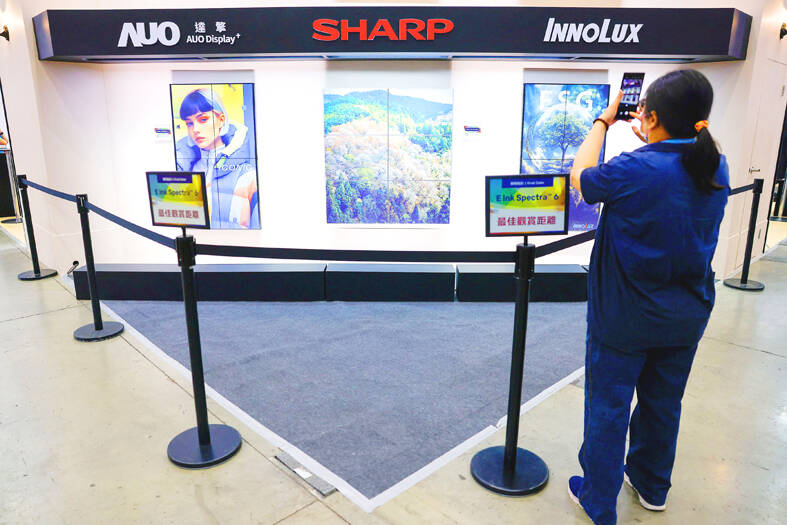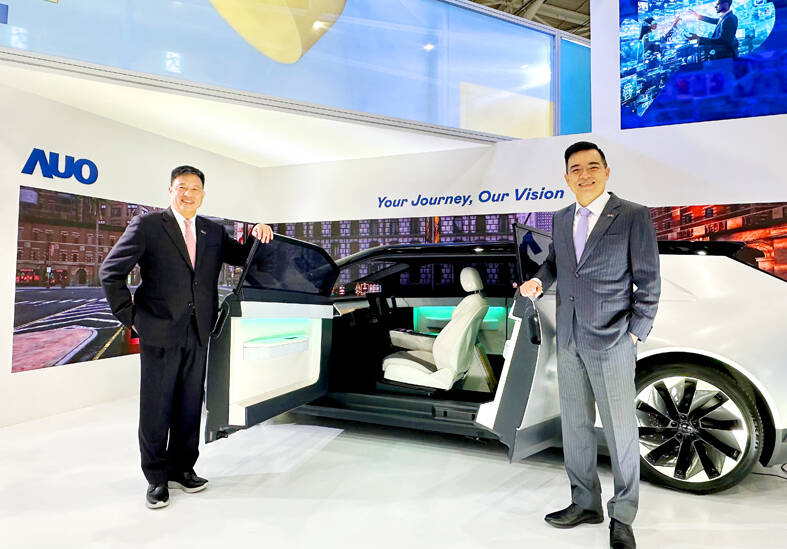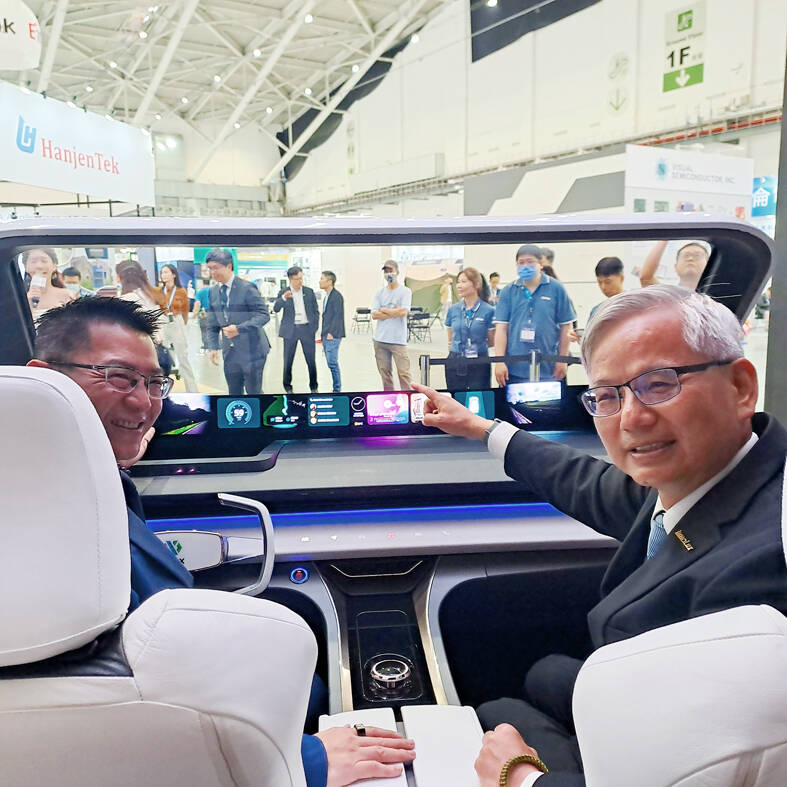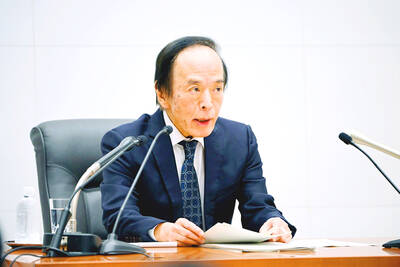Flat-panel display makers AUO Corp (友達) and Innolux Corp (群創) yesterday said that about 12 to 20 percent of their display business is at risk of potential US tariffs and that they would relocate production or shipment destinations to mitigate the levies’ effects.
US tariffs would have a direct impact of US$200 million on AUO’s revenue, company chairman Paul Peng (彭雙浪) told reporters on the sidelines of the Touch Taiwan trade show in Taipei yesterday.
That would make up about 12 percent of the company’s overall revenue.

Photo: Ann Wang, Reuters
To cope with the tariff uncertainty, AUO plans to allocate its production to manufacturing facilities in countries subject to lower US “reciprocal” tariffs, leveraging its global manufacturing footprint, Peng said.
The company has added new manufacturing sites in India, Europe and Mexico following the acquisition of BHTC GmbH, a German cockpit operation system supplier, he said.
The company would not consider building a front-end display manufacturing facility in the US, due to expensive labor costs and the lack of a comprehensive display supply chain in the country, he said.

Photo: Chen Mei-ying, Taipei Times
Innolux also said it had no plans to build a manufacturing site in the US.
As a major vehicle and TV display supplier to tier-one customers, Innolux has a bigger US exposure than other display and component suppliers, chief executive officer Jim Hung (洪進揚) told a news conference in Taipei.
The company ships vehicle displays directly to customers in the US and Europe, with direct exposures of up to 8 to 10 percent, and as TV brands are among its tier-one customers, it has to directly ship TV displays to the US, Hung said.

Photo: CNA
Indirect exposures to the US accounted for about 10 to 15 percent, he said.
Like most component suppliers, Innolux also ships its displays to electronic assemblers’ factories in China, Vietnam, Thailand and other regions, he said.
In the face of rising uncertainty, Innolux has activated a stringent supply chain management mechanism as it did during the COVID-19 pandemic, Hung said.
The aim is to ensure an optimal level of component inventory as customers are scrambling to stock up on as many goods as possible at their hubs during the 90-day tariff pause announced last week by US President Donald Trump, he said.
With the lasting tariff challenges and geopolitical risks, Innolux would be more “selective in terms of manufacturing sites and partners,” compared with its strategies during the pandemic, he said.
The company is considering shifting more TV panels to TV makers in Mexico from China, given that Mexico is subject to a significantly lower US import duty than China, he said.
AUO and Innolux reported new rush orders this quarter as customers strive to avoid US tariffs.
Hung said second-quarter revenue would outgrow Innolux’s original forecast, but he expects a weaker revenue performance in the third quarter.
The US’ fickle tariff policy has upended the display industry’s seasonal patterns, Peng said, adding that AUO’s revenue forecast in February is no longer suitable.
At that time, AUO had predicted revenue to grow gradually each quarter, he said.

Taiwan’s long-term economic competitiveness will hinge not only on national champions like Taiwan Semiconductor Manufacturing Co. (TSMC, 台積電) but also on the widespread adoption of artificial intelligence (AI) and other emerging technologies, a US-based scholar has said. At a lecture in Taipei on Tuesday, Jeffrey Ding, assistant professor of political science at the George Washington University and author of "Technology and the Rise of Great Powers," argued that historical experience shows that general-purpose technologies (GPTs) — such as electricity, computers and now AI — shape long-term economic advantages through their diffusion across the broader economy. "What really matters is not who pioneers

In a high-security Shenzhen laboratory, Chinese scientists have built what Washington has spent years trying to prevent: a prototype of a machine capable of producing the cutting-edge semiconductor chips that power artificial intelligence (AI), smartphones and weapons central to Western military dominance, Reuters has learned. Completed early this year and undergoing testing, the prototype fills nearly an entire factory floor. It was built by a team of former engineers from Dutch semiconductor giant ASML who reverse-engineered the company’s extreme ultraviolet lithography (EUV) machines, according to two people with knowledge of the project. EUV machines sit at the heart of a technological Cold

TAIWAN VALUE CHAIN: Foxtron is to fully own Luxgen following the transaction and it plans to launch a new electric model, the Foxtron Bria, in Taiwan next year Yulon Motor Co (裕隆汽車) yesterday said that its board of directors approved the disposal of its electric vehicle (EV) unit, Luxgen Motor Co (納智捷汽車), to Foxtron Vehicle Technologies Co (鴻華先進) for NT$787.6 million (US$24.98 million). Foxtron, a half-half joint venture between Yulon affiliate Hua-Chuang Automobile Information Technical Center Co (華創車電) and Hon Hai Precision Industry Co (鴻海精密), expects to wrap up the deal in the first quarter of next year. Foxtron would fully own Luxgen following the transaction, including five car distributing companies, outlets and all employees. The deal is subject to the approval of the Fair Trade Commission, Foxtron said. “Foxtron will be

INFLATION CONSIDERATION: The BOJ governor said that it would ‘keep making appropriate decisions’ and would adjust depending on the economy and prices The Bank of Japan (BOJ) yesterday raised its benchmark interest rate to the highest in 30 years and said more increases are in the pipeline if conditions allow, in a sign of growing conviction that it can attain the stable inflation target it has pursued for more than a decade. Bank of Japan Governor Kazuo Ueda’s policy board increased the rate by 0.2 percentage points to 0.75 percent, in a unanimous decision, the bank said in a statement. The central bank cited the rising likelihood of its economic outlook being realized. The rate change was expected by all 50 economists surveyed by Bloomberg. The